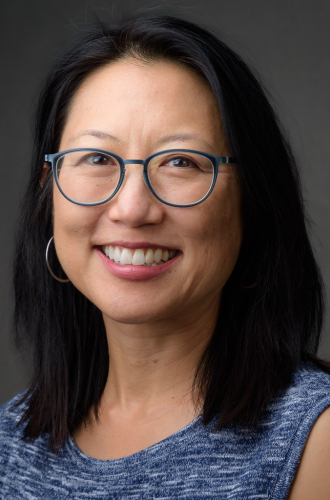-

-

-
Amy Lee
Professor
Department of Neuroscience, College of Natural Sciences
Karl Folkers Chair in Interdisciplinary Biomedical Research II (Fellow)Ion channels, Ca2+ signaling, synapses, retinal circuits, nerve regenerationamy.lee1@austin.utexas.edu
Phone: 512-471-1156
Office Location
NHB 3.139
Postal Address
100 E 24TH ST
AUSTIN, TX 78712-
Amy Lee received her PhD in Neuroscience at the University of Virginia under the mentorship of Kevin Lynch and went on to postdoctoral work with William Catterall at the University of Washington. She began her independent research career in 2002 as Assistant Professor in the Dept. of Pharmacology at Emory University. In 2009, she moved to the Dept. of Molecular Physiology and Biophysics at the University of Iowa, where she rose through the ranks to full professor in 2015 and also served as Assistant Dean for Research in the Carver College of Medicine from 2014-2019. She is broadly interested in the structure/function relationships of voltage-gated Ca2+ channels, and the roles that these channels play in orchestrating the development and mature function of the nervous system.
-
Structure/function relationships of voltage-gated (Cav) Ca2+ channels: We are studying the molecular determinants and protein interactions that regulate the biophysical properties of Cav channels. Technical approaches include patch-clamp electrophysiology, voltage-clamp fluorometry, FRET, and isothermal titration calorimetry. A major goal of this project is to generate modified Cav channels to study their roles within neuronal cell-types and circuits.
Ca2+ signaling mechanisms controlling axonal regeneration: We are investigating a novel pathway involving Cav channels and calmodulin-like Ca2+ binding proteins (CaBPs) in sensory neurons. We are determining how Cav coupling to CaBPs alters the regenerative growth of axons in vitro, and the recovery of sensory function following nerve injury in vivo. Techniques include live-cell imaging, single-cell RNAseq, and machine-learning approaches for analyzing neuronal morphology.
Cav and other ion channels and retinal circuit development and function: We are investigating the roles of Cav channel subtypes in regulating photoreceptor synapse assembly, and how dysregulation of these channels lead to aberrant and homeostatic forms of rewiring within retinal circuits. Techniques include multi-photon imaging/electrophysiology in retinal tissue, behavioral analyses of visual function, and imaging (super-resolution and electron microscopy) of protein localization and synaptic structure.
-
Representative publications
Lee, A., Wong, S.T., Gallagher, D., Li, B., Storm, D.R., Scheuer, T., and W.A. Catterall. (1999) Ca2+/calmodulin binds to and modulates P/Q-type calcium channels. Nature 399:155-159
Zhou, H., Kim, S.-A., Kirk, E.A., Tippens, A. L., Sun, H., Haeseleer, F., and A. Lee. (2004) Ca2+-binding protein-1 facilitates and forms a postsynaptic complex with Cav1.2 (L-type) Ca2+ channels. J. Neurosci. 24:4698-4708
Calin-Jageman, I., Yu, K., Hall, R.A., Mei, L., and A. Lee. (2007) Erbin enhances voltage-dependent facilitation of Cav1.3 Ca2+ channels through relief of an autoinhibitory domain in the Cav1.3 α1 subunit J. Neurosci. 27:1374-1385
Jenkins, M.A., Christel, C.J., Jiao, Y., Abiria, S., Kim, K.Y., Usachev, Y.M., Obermair, G.J., Colbran, R.J., and A. Lee. (2010) Ca2+-dependent facilitation of Cav1.3 Ca2+ channels by densin and Ca2+/calmodulin-dependent protein kinase II. J. Neurosci. 30:5125-5135
Gregory, F.D., Bryan, K.E., Pangršič ,T., Calin-Jageman,I.E., Moser, T., and A. Lee. (2011) Harmonin inhibits presynaptic Cav1.3 Ca²⁺ channels in mouse inner hair cells. Nat. Neurosci. 14:1109-1111
Inagaki, A., Frank C.A., Usachev, Y.M., Benveniste, M., and A. Lee. (2014) Pharmacological correction of gating defects in the voltage- gated Cav2.1 Ca2+ channel due to a familial hemiplegic migraine mutation. Neuron 81: 91-102
Wang S, Stanika RI, Wang X, Hagen J, Kennedy MB, Obermair GJ, Colbran RJ, Lee A. (2017) Densin-180 controls the trafficking and signaling of voltage-gated Cav1.2 Ca2+channels at excitatory synapses. J. Neurosci. 37:4679-4691.
Kerov, V., Laird, J.G., Joiner, M.L., Knecht, S., Soh, D., Hagen, J., Gardner, S.H., Gutierrez, W., Yoshimatsu, T., Bhattarai, S., Puthussery, T., Artemyev, N.O., Drack, A.V., Wong, R.O., Baker, S.A., and A. Lee. (2018) a2d-4 is required for the molecular and structural organization of rod and cone photoreceptor synapses. J. Neurosci. 38: 6145-6160.
Thomas, J.R., Hagen, J., Soh, D., and A. Lee. (2018) Molecular moieties masking Ca2+- dependent facilitation of voltage-gated Cav2.2 Ca2+ channels. J. Gen. Physiol. 150: 83-94.
Williams, B., Haeseleer, F., and A. Lee. (2018) Splicing of an automodulatory in Cav1.4 Ca2+ channels confers distinct regulation by calmodulin. J. Gen. Physiol. 150:1676- 1687.
Maddox, J.W., Randall,K., Williams, B, Hagen, J, Derr, P.J., Kerov, V., Della Santina, L, Baker S.A., Hoon, M., and A. Lee. (2020) A dual role for Cav1.4 Ca2+ channels in the molecular and structural organization of the rod photoreceptor synapse. eLife 9:e62184
-
1986 National Merit Scholar
1986 University of Michigan Alumni Scholarship
1990 Graduation with Distinction, University of Michigan
1995 Individual pre-doctoral NRSA F31 MH11074-01
1997 Eric Lothman Award in Recognition of Outstanding
Achievement in Neuroscience, University of Virginia
1998 Individual post-doctoral NRSA F32 NS10645-01
2002 PhRMA Foundation Research Starter Award
2007 Department of Pharmacology, Emory University School of
Medicine, Teaching Excellence Award
2011 Carver Research Program of Excellence Award
2012 Elected to Biophysical Society Council
2014 Women of Innovation Award, Technology Association of Iowa
2015 AAMC Basic Research Video Competition Award https://medresearch.tumblr.com/GRANDwinner
2016 University of Iowa Faculty Communicating Ideas Award
2017 University of Iowa Diversity Catalyst Award
-














